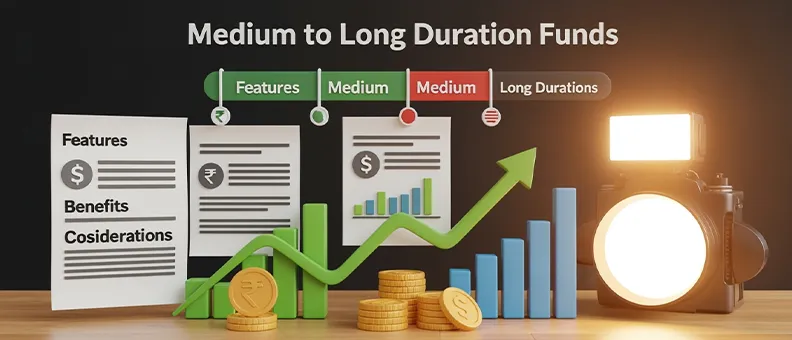Medium to Long Duration Funds: Features, Benefits and Considerations Before Investing


While there are plenty of options available in mutual funds today, those looking for a higher return potential than traditional savings options but with relatively lesser volatility than equities can consider medium to long duration mutual funds. These funds aim to generate gains through interest payments and interest rate movements, offering the potential for reasonable returns a medium to long investment horizon.
In this article, we will understand what medium to long duration mutual funds are, their features and potential benefits.
- Table of contents
- Medium to long duration mutual funds – The meaning
- Medium to long duration funds – The key features
- Investing in medium to long duration funds
- The role of interest rate movements
Medium to long duration mutual funds – The meaning
Medium to long duration mutual funds is a category of debt mutual funds that invest in fixed-income instruments like government securities and corporate bonds.
According to the SEBI (Securities and Exchange Board of India) guidelines, medium to long duration funds must maintain a portfolio Macaulay duration of 4 to 7 years. While adhering to these norms, medium to long duration funds can actively manage their portfolios to benefit with changing interest rate scenarios, optimise potential returns, and offer relative stability of capital.
Read Also: Short Term vs Long Term Mutual Funds: Pros and Cons
Medium to long duration funds – The key features
Portfolio duration
This is defined as the average time it takes for the fund’s investments to be repaid. Medium to long duration funds usually take more time to mature compared to ultra short and short duration funds. The longer the duration of a scheme, the more the fund's value can rise or fall when interest rates change––which makes these instruments more sensitive to rate movements when compared to funds with shorter durations.
Diversification
Medium to long duration funds invest in many different debt instruments of varying maturities and issuers. If one investment falters, others can help mitigate the impact on the overall portfolio performance.
Professional management
Investment professionals manage these funds, studying market conditions to adjust the portfolio mix to improve risk-adjusted return potential.
Liquidity
These funds are typically quite liquid, so you can initiate investments or redemptions whenever you wish to (standard settlement timelines apply as per the AMC’s policies).
Potential for income
Debt funds generate income through interest payments from the issuers of the underlying securities. Investors seeking the potential for regular income can thus consider such funds.
Reasonable growth potential
Apart from interest payments, debt funds can also earn returns if the market value of the underlying securities increases. When the prevailing interest rates in the economy are lowered, the value of existing bonds and other fixed income securities typically rises. This can result in an increase in the fund’s Net Asset Value. Conversely, if interest rates rise, the values of underlying bonds may drop. This is known as interest rate risk.
Investing in medium to long duration funds
Here are some factors to consider when investing in medium to long duration funds:
- Investment horizon: As their names suggest, these funds are suitable for investors with a medium to long-term horizon.
- Risk appetite: Investors should be comfortable with some amount of volatility. While medium to long duration funds are relatively stable compared to equity mutual funds, they are more volatile because of their sensitivity to interest rate changes than debt funds with shorter durations (such as short-term and ultra-short-term debt funds).
- Market conditions: These funds can benefit when interest rates are expected to fall. Hence, keeping an eye on RBI policy announcements and economic indicators can be helpful. In rising interest rate environment, such a fund may not be suitable.
- Fund selection: When choosing a fund, it’s important to check past performance*, expense ratio, portfolio credit quality and the fund manager's experience.
*Past performance may or may not be sustained in future.
The role of interest rate movements
Bond prices are inversely related to interest rates. When interest rates rise, the market value of older bonds fall. This is because new bonds that will now enter the market will be issued at higher rates. As a result, existing bonds with lower rates become less attractive.
- Falling interest rates: When interest rates fall, bond prices go up. The longer the portfolio duration, the more the impact of interest rate changes. So, medium and long duration bonds have the potential to benefit more from a rate drop than short-term funds.
- Rising interest rates: Similarly, when interest rates rise, the value of the bonds held by the fund may fall, causing a decline in the fund’s NAV (Net Asset Value). Again, bonds and debt funds with longer durations tend to be more affected that short-term securities.
Therefore, medium to long duration debt funds are more sensitive to interest rate movements. Understanding these dynamics helps investors decide when to enter or exit these funds.
Conclusion
Medium to long duration mutual funds can be a suitable option for investors looking for the potential for relatively stable returns over the medium to long-term with moderate risk. While these funds are more sensitive to interest rate movements than shorter duration funds, they also have the potential to deliver better returns in falling interest rate conditions.
Read Also: Short vs. Long Duration Debt Funds: Meaning, Benefits and Tips to Choose?
FAQs:
What is the typical investment horizon for medium to long duration debt mutual funds?
A suitable investment horizon for such funds may be four years or more.
What risk profile do medium to long duration funds carry?
These funds typically carry moderate risk. They are more volatile than liquid or short-term debt funds but less risky than equity mutual funds.
How can investors assess the sensitivity of these funds to interest rate changes?
Investors can assess interest rate sensitivity by looking at a fund’s modified duration, which estimates how much the fund’s value is expected to change with a 1% change in interest rates.
Mutual Fund investments are subject to market risks, read all scheme related documents carefully.
This document should not be treated as endorsement of the views/opinions or as investment advice. This document should not be construed as a research report or a recommendation to buy or sell any security. This document is for information purpose only and should not be construed as a promise on minimum returns or safeguard of capital. This document alone is not sufficient and should not be used for the development or implementation of an investment strategy. The recipient should note and understand that the information provided above may not contain all the material aspects relevant for making an investment decision. Investors are advised to consult their own investment advisor before making any investment decision in light of their risk appetite, investment goals and horizon. This information is subject to change without any prior notice.
The content herein has been prepared on the basis of publicly available information believed to be reliable. However, Bajaj Finserv Asset Management Ltd. does not guarantee the accuracy of such information, assure its completeness or warrant such information will not be changed. The tax information (if any) in this article is based on prevailing laws at the time of publishing the article and is subject to change. Please consult a tax professional or refer to the latest regulations for up-to-date information.